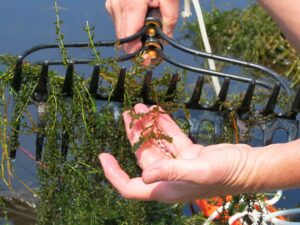Monitoring
Aquatic plant management: monitoring
 What is monitoring?
What is monitoring?
Monitoring is an important component of a plant management control effort. Aquatic plant monitoring is a routine (usually annual but sometimes more frequent) measurement of the characteristics of an aquatic plant population (e.g., how large an area, which species are present). A monitoring program should include not only an assessment of the distribution of the target invasive plant species but also an assessment of the beneficial native plant communities in the water body. Understanding the changes in a plant population will help determine 1) whether control efforts are needed and 2) if control efforts are undertaken, whether they are effective.
Benefits and drawbacks of monitoring
There are many benefits of monitoring. Most monitoring programs include a water quality component, which is important in understanding the overall health and well-being of the lake. Specifically for aquatic plant management, monitoring not only provides information on the current status of aquatic plant populations (which plants and where they are) but also informs stakeholders of any changes in aquatic plant populations (if current populations are expanding, and if there are new plant species). Understanding how populations are changing will inform potential control strategies. For example, a large increase in aquatic plants in a specific area near the shoreline may be due to a leaking septic tank. Monitoring the nutrient levels and plant populations may help identify this issue and prevent a costly herbicide treatment. Also, finding a new species early may offer a chance to remove it before it spreads, or at least save time and money by controlling it while it is a small population. The drawback of monitoring is that it requires a combination of effort and/or cost. Stakeholder volunteers can perform the monitoring for a very low cost, but this requires time. Conversely, a professional service provider can be hired to do the monitoring, but at a higher cost.
How to conduct monitoring?
Monitoring can be done by the lake group as a stand-alone effort, or monitoring can occur as part of a statewide monitoring network. While an independent effort may offer more flexibility, undertaking monitoring as part of a larger program offers many benefits. These programs, such as the Wisconsin Citizen Lake Monitoring Network, offer technical assistance, materials and training that alleviate the need for the lake group to develop these components themselves. While these programs include a variety of water quality measurements, they also include an aquatic invasive species component that will assist in tracking the growth and spread of aquatic plants.
Who does the monitoring?
Many lakes join a statewide network that provides materials, training and general assistance to individuals who live on the lake and are interested in volunteering. Another option is to hire a service provider to complete the monitoring. The cost of a consultant will depend on the size of the lake and which parameters the monitoring will measure (e.g., water quality data, aquatic plants).